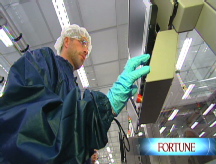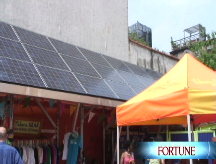Solar stocks for a rainy day
The industry has taken a beating in the market lately, but a few standouts may shine in the long run.
 |
| SunPower CEO Tom Werner and his solar module, on the grassy roof of the California Academy of Sciences in San Francisco. |

(Fortune Magazine) -- No one loves Arnold Schwarzenegger more than the solar industry. Kicking off the nation's largest gathering devoted to all things sunny, the California governor won thunderous applause and two standing ovations from the crowd of 20,000 at the San Diego Convention Center. "What's green for the environment can also be green for the economy," he said. "Solar is the future; it's now; it can't be stopped."
For those four days in October, the Solar Power International 2008 convention drew attendees from 70 countries and generated lines stretching out the door for parking, food, and just about everything else. It seemed as if the power of the sun could conquer all. You wouldn't have guessed that just a week before, the financial meltdown had felled sector after sector, including the once-shining solar industry.
It's not that this swelling crowd thinks the macroeconomic troubles the world faces won't affect the solar industry; they know they will. All the leading solar companies have already seen the value of their stocks plummet far more than the 36% the Nasdaq has dropped from the beginning of the year to Oct. 21. The value of the Claymore/MAC global solar energy index (TAN), an ETF comprising global solar stocks, has dropped 56% since it started trading in mid-April.
Given the uncertainty of the economy, some analysts fear that the solar industry's customers could have trouble financing utility-scale solar projects that use lots of modules. Most residential solar installations, which can cost $20,000 to $30,000, require homeowners to borrow, and that money has all but disappeared. Subsidies in Spain, a huge market in recent years, are decreasing, and it is an open question whether countries that have new subsidies coming online, like Italy, Greece, and France, will fill the void.
In contrast to the 1980s - when solar companies got swept away by cheap oil, withdrawn government subsidies, or steep economic downturns - the sense this time is that the industry is here to stay. And not just stay and survive, but stay and flourish. Concern over climate change, combined with falling prices for solar technology, has made this source of carbon-free electricity more attractive than ever. The worldwide market for solar energy roughly doubled last year, to $33 billion, and analysts expect revenues to grow 33% a year for the foreseeable future. What began as a technology championed by tree huggers and pot growers is now a global market that Lux Research, based in New York City, says will reach about $100 billion in sales within the next five years. Germany, Japan, and Spain rank as the top markets for solar power, but other Western European nations are coming on fast, as are China and the U.S. As part of the bailout package, Congress extended the 30% investment tax credits for clean energy, which should give a boost to the American market.
"Solar has become a real industry," says Marc Porat, a Silicon Valley veteran and chairman of green-building-materials company Serious Materials. Porat was at the conference in San Diego scouting for solar-electricity generating systems for another green project of his. Looking around the hall packed with startups selling everything from tools for manufacturing solar cells to rooftop hardware for mounting equipment to software for analyzing power needs, Porat emphasizes his point. "You can see that all the gaps in the market have been filled by multiple companies," he says. "It's the same with any good entrepreneurial opportunity."
After 30-plus years of steady improvement, solar electric technology is going mainstream. Photovoltaic (PV) panels, which convert sunlight directly into electricity, can increasingly be found on residential rooftops, warehouses, and Wal-Marts. Large-scale photovoltaic solar farms cover huge swaths of land to supply utilities with clean power. Entrepreneurs have also invested in solar thermal farms, where the sun's heat turns liquid into steam to drive a turbine.
Even with state-of-the-art manufacturing methods, PV solar power is still on average twice as expensive to produce as electricity generated by a coal-fired plant. But prices are finally coming down even as efficiency goes up, and some experts think the cost of solar will rival grid power in the next two to three years. In the meantime, government subsidies are bridging the cost gap in many markets. Also, as more nations pass carbon cap-and-trade laws - in the U.S. both Senators McCain and Obama support the idea - natural gas and coal will become more expensive, which should close the gap further. Finally, the industry has achieved scale. These are not backyard enterprises - they pull in hundreds of millions in revenue annually and do business everywhere on the planet. That they all are pursuing economies of scale should help drive down the cost of solar even further.
Although the industry is able to sell solar cells and modules today as fast as it can make them, analysts predict capacity will almost double in 2009. That has caused some analysts to raise the specter of over-supply and the possibility of a bloody price war among manufacturers. "It's going to trigger a shakeout," says Ted Sullivan, a senior analyst with Lux. "The weakest players will either get acquired or fail."
While industry players mostly disagree with Sullivan on the inevitability of aggressive price wars, they do see an upcoming shift in the industry. "I think we all agree that markets tend to consolidate during times like these," says Tom Werner, CEO of SunPower, a maker of solar-power-generating systems. "This is one of those periods in an industry where a handful of big players emerge."
Of the 14 pure-play public solar companies, experts expect at least three to stand out from the crowd. The winners possess differentiated technology, enough cash to survive, and the financial heft to enter the entire solar food chain, from producing modules to selling power like any other utility. While the industry is likely to remain volatile for some time to come, long-term investors might want to consider stocks of these three companies, whose values now look attractive.
Among the favorites of stock analysts is First Solar (FSLR). Founded in 1999 and originally backed by the investing arm of the Walton (Wal-Mart) family, First Solar went public in 2006, right at the beginning of a wave of solar IPOs. In the coming shakeout First Solar should thrive, because with its cutting-edge thin-film technology it is able to produce solar modules more cheaply per watt than its competitors. Traditional crystalline-silicon photovoltaic systems sandwich wafers of silicon between glass, resulting in those boxy panels you see on rooftops. By contrast, First Solar's thin-film technology applies a fine layer of material directly to a glass substrate. The process is faster, and because it requires just a fraction of the expensive silicon used in traditional PVs, it's vastly cheaper. First Solar, which operates factories in Ohio, Malaysia, and Germany, can produce systems for $1.14 per watt of power, compared with $2.90 per watt for traditional crystalline-silicon solar cells. With subsidies, First Solar's products can compete in many parts of the world with a natural gas or coal-fired power plant.
Run by managers who are fanatics about meeting goals and avoiding unnecessary costs, First Solar routinely blows away both its own and the Street's targets. Its manufacturing team is legendary, bringing online factories that exceed expectations. "They come in at over 100% of projected capacity," says Jenny Chase, a senior analyst with New Energy Finance. "No one else does that."
The shares of this highflying Tempe, Ariz., company peaked at $317 in May and now are trading at $144. Analysts expect sales this year to reach $1.2 billion, up 138% from 2007, and to top $2.1 billion next year, with earnings per share more than doubling. First Solar also sits on $633 million in cash. While the stock is pricey with a current P/E of 50 and a forward P/E of 21, the company's growth prospects and strong balance sheet make it look like a buy.
While First Solar has laid claim to the lowest price per watt for its modules, SunPower (SPWRA) claims the most efficient. Inch for inch, its modules produce the most electricity. While SunPower's systems are expensive, you need fewer of them, which makes them perfect for homes and businesses where space is tight. The company, based in San Jose, was spun out of Cypress Semiconductor in 2005 and now sports a $4.2 billion market cap - about eight times the size of its former parent. It has carved out a place in the solar industry similar to Apple's in the computer world, producing well-designed, aesthetically pleasing modules. SunPower has distinguished itself in the market as one of the highest-quality makers of modules. "Brand actually does matter in this industry," New Energy's Chase says, "and SunPower has it."
Besides making and installing systems, SunPower has started on a new track. Much like a utility, it has decided to sell the power its modules produce directly to customers. But that new strategy hasn't kept the stock from getting hammered. Over the past year, SunPower stock fell from a 52-week high of $164 to a low of $37 in early October. Werner is shocked by the drubbing his stock has taken. "The markets are valuing growth companies as if they were lead-pencil companies," he says. "This will take care of itself in time, and we are obviously in a really, really unique time."
Now trading at around $54, with a current P/E of 60 and a forward P/E of 12, this stock, too, looks like a buy. Analysts expect SunPower's sales this year to hit $1.4 billion, up 80% from 2007, and to rise to $2 billion in 2009. Earnings per share are expected to rise from $2.33 in 2008 to $3.55 in 2009, a 52% increase.
While SunPower is obsessed with quality, what solarmaker Suntech Power (STP) offers is scale. Based in Wuxi, China, the company is the world's largest manufacturer of solar PV modules and has set in place an aggressive plan to stay on top, says Roger Efird, who runs Suntech's business in the Americas. With a cash hoard of $752 million, access to cheap local labor, and deep-pocketed Chinese lenders backing it up, the company has been able to take advantage of the fast-growing market. Efird, who is also chairman of the U.S. Solar Energy Industry Association, believes the risk of price declines in solar modules next year will be offset by continued thirst for new sources of clean energy in both China and the U.S.
Wedged in by people filling Suntech's booth at the San Diego solar conference, Efird looks around the hall. "There's not a person in this room who has a module for sale between now and the end of the year. It's all sold out," he says. "What people forget is that there are hundreds upon hundreds of solar projects, in the U.S. in particular, sitting on the shelf waiting for the right economic moment." Efird believes that moment is coming next year.
To hedge its bets, Suntech, like its competitor SunPower, is moving up the food chain, selling power directly to commercial customers. That's not Suntech's only hedge. The company has invested tens of millions to lock in the price of silicon over the next five to ten years, betting that demand will rise and prices eventually will trend up. Competing manufacturers without Suntech's resources will have to face the vagaries of the spot market for silicon in years to come. Of course, if silicon prices drop - new capacity is coming onstream - the move could prove a costly mistake for Suntech.
Suntech's share price has fallen from a 52-week high of $90 in January to $18 in mid-October. It looks cheap, with a current P/E of 17 and a forward P/E of 9. This year's sales, stemming mostly from its business in Asia, are estimated to clock in at $2.1 billion, up 62% over 2007, rising to $3.2 billion in 2009, as it pushes hard in the U.S. Earnings per share are projected to go from $1.67 this year to $2.50 next.
The shares of even the best solar companies have fallen on hard times. Yet for anyone who believes that the world is destined to move away from a carbon-based economy, investing in this nascent industry, at least in the long term, may very well be a move you won't regret. ![]()
-
 The retail giant tops the Fortune 500 for the second year in a row. Who else made the list? More
The retail giant tops the Fortune 500 for the second year in a row. Who else made the list? More -
 This group of companies is all about social networking to connect with their customers. More
This group of companies is all about social networking to connect with their customers. More -
 The fight over the cholesterol medication is keeping a generic version from hitting the market. More
The fight over the cholesterol medication is keeping a generic version from hitting the market. More -
 Bin Laden may be dead, but the terrorist group he led doesn't need his money. More
Bin Laden may be dead, but the terrorist group he led doesn't need his money. More -
 U.S. real estate might be a mess, but in other parts of the world, home prices are jumping. More
U.S. real estate might be a mess, but in other parts of the world, home prices are jumping. More -
 Libya's output is a fraction of global production, but it's crucial to the nation's economy. More
Libya's output is a fraction of global production, but it's crucial to the nation's economy. More -
 Once rates start to rise, things could get ugly fast for our neighbors to the north. More
Once rates start to rise, things could get ugly fast for our neighbors to the north. More










